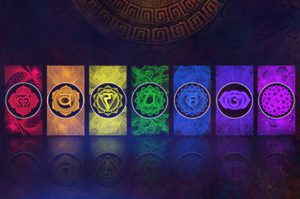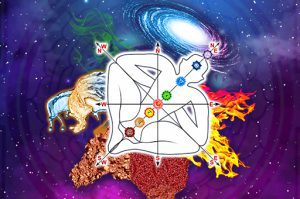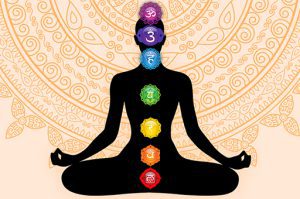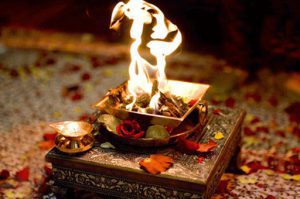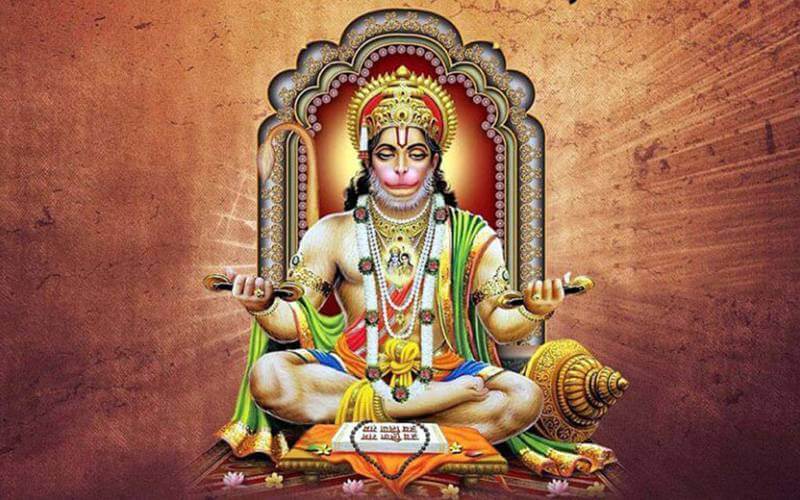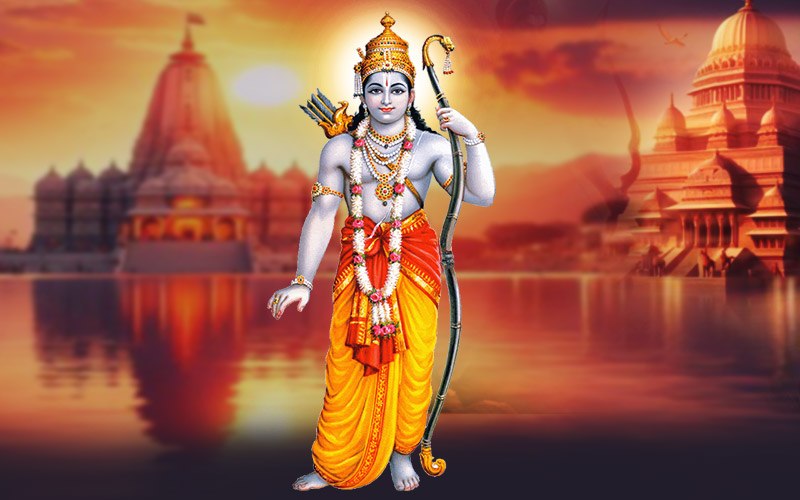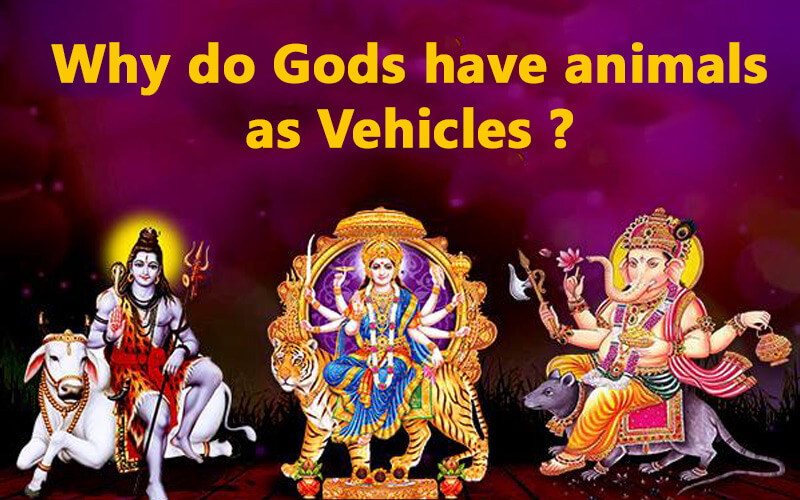
All Gods and Goddess are depicted with particular vahanas (Vehicle). The positive aspects of the vehicle are often representative of the God and the negative attributes are the qualities that the God energy has tamed. The vahana and deity to which they support are in a reciprocal relationship. Gods and Goddess are the energies we need to awaken within in our journey of realizing self. To realize who we are, we have to realize who we are not and tame it. The Vahana is the Ego that is tamed for the fulfillment of the realized Divine energy. The God/Goddess may be seen sitting, standing or riding the vahana or at times the vahana may be seen sitting near the God. These Vahana are the representation of the various energies (animal energies) that exists in the universe as well as in human beings and they need to be controlled and channelled properly so as to transform ourselves spiritually. Each god or goddess is in-charge of a particular energy which he or she rides and controls at his or her will. These energies are present in man, mostly as wild animal energies and they need to be controlled and channelled properly in order to transform the lower self and establish divine consciousness in him. The looks of the Gods and Goddess are also symbolic of the message they carry.. so Krishna is beautiful, holding music, surrounding by delicious food and gopikas as He represents the taste, beauty and joy of life.. Vishnu is calm serene in the Ocean and depicts Opulence in Vaikuntha to symbolize creation process.. Shiva has smeared himself with ashes and holds a spear and damru to signify the destruction of human within to realize the eternity within.Some Gods and their Vahanas
Lord Siva rides on His Vahana Nandi the Bull that stands for the bullying, aggressive, blind and brute ego in man that has capacity to destroy him. We all know about bull fighting where bulls fight for no apparent purpose. The bull symbolizes untamed power and ignorance. It also stands for unbridled sexual energy, Kama. Only Lord Siva can help us control these and transform them. Shiva tames the ego like bull within us as by transforming
Untamed Power to tamed power
Ignorance to Wisdom
Kama to Kundalini energy
Shiva is called the destroyer as He takes you out of illusory Maya and transforms you into the Pure soul that you are to live your Life purpose. He resides as Mahamrityunjaya, Pashupatinath and Adi shiva among His different forms in our chakras.
Lord Vishnu
The peace-loving deity of the Hindu Trinity, Vishnu is the Preserver or Sustainer of life with his steadfast principles of order, righteousness and truth. When these values are under threat, Vishnu emerges out of his transcendence to restore peace and order on earth. His vehicle is Garuda, the king of the birds. He mocks the wind with the speed of his flight. Garuda represents the human thoughts which can fly in all directions at the incredible speed. Lord Vishnu riding over Garuda symbolizing the capacity of controlling thoughts. The important point is that Garuda represents the five vayus within us : prana, vyana, udana, samana, brahmana through his five forms Satya, Suparna, Garuda, Tarkshya, Vihageshwara. These five vayus through yoga can be controlled through Pranayama which can lead to Kundalini awakening leading to higher levels of consciousness. Shesha is generally depicted with a massive form that floats coiled in space, or on the universal ocean, to form the bed on which Vishnu lies. Sometimes he is shown as five-headed or seven-headed, but more commonly as a many hundred-headed serpent, sometimes with each head wearing an ornate crown. Kundalini literally means coiled. In Indian yoga, a “corporeal energy” – a Shakti that lies coiled at the base of the spine. It is envisioned either as a goddess or else as a sleeping serpent. The Kundalini resides in the sacrum bone in three and a half coils and has been described as a residual power of pure desire. Ananta means endless and Sis means “that which remains”. It is said that when the world is destroyed at the end of the kalpa, Shesha is all that remains. Vishnu sleeping on Sesha symbolizes Him taming Shesha that floats on cosmic waters that represents the peaceful Universe– The calm, fearlessness, patience and desire less state that is required for creation.
Ganesh
“ The remover of obstacles” – the wise, elephant headed Ganesh is one of the the Hindu’s most popular deities. He is the remover of obstacles, the deity who is first acknowledged whey worshippers do anything in their lives. He rides over a rat- that is a fearful tinny winny in structure who robs or steals under the cover of darkness and runs away at the slightest sign of danger. The name mooshika is derived from Sanskrit term moosh, which means to steal. A Rat will come out in the comfort of darkness to steal and bite and eat everything that it will come across. It signifies lust and greed and an ignorant mind. Human mind is akin to a rat, the mind being wavering and selfish. A mouse also represents the timidity and the nervousness that overwhelm us at the onset of any new venture. Thus when a ship sinks, the rats are the first ones to run away. Also as rats multiply rapidly, our thoughts also multiply with fears. Ganesha sitting on a mouse depicts all such running away, multiplication, nervousness, greed, lust and stealing attitude of man being tamed when he awakens the power of Ganesh. Ganesh represents standing on one’s feet and taking charge of his life and facing obstacles in the face through Riddhi and Siddhi. Lord Ganesha takes us towards our initiative without any obstacles.
Lord Brahma:
“The God of Creation”- Brahma is usually conceived as a bearded, four-faced, four-armed deity. In popular images, He carries a rosary in the upper right hand, Vedas in the upper left hand, a kamandalu (water pot) in the lower left hand, and bestows grace with His lower right hand. The four faces represent the sacred knowledge of the four Vedas (Rig, Yajur, Sama, and Atharva), and this is the most prominent feature of any image of Brahma. The four faces, therefore, symbolize that Brahma is the source of all knowledge necessary for the creation of the universe. The four arms represent the four directions and thus represent the omnipresence and omnipotence of Lord Brahma. In Hindu mythology, a swan is said to possess a unique discriminating faculty, which enables it to distinguish pure milk from a mixture of milk and water. This divine bird is bestowed with a virtue called Neera-Ksheera Viveka or the ability to separate milk and water from a mixture of the two. The swan is therefore used to symbolize the power of discrimination. Brahma uses the swan as a vehicle to symbolize that true knowledge can be acquired by an individual by training his mind and Intellect to acquire the power of right discrimination. The significance of this is that justice should be dispensed to all creatures, however entwined it might be in a situation. Also, this virtue indicates that one should learn to separate the good from the evil and then accept that which is valuable and discard that which is worthless or evil.
Lord Brahma:
“The God of Creation”- Brahma is usually conceived as a bearded, four-faced, four-armed deity. In popular images, He carries a rosary in the upper right hand, Vedas in the upper left hand, a kamandalu (water pot) in the lower left hand, and bestows grace with His lower right hand. The four faces represent the sacred knowledge of the four Vedas (Rig, Yajur, Sama, and Atharva), and this is the most prominent feature of any image of Brahma. The four faces, therefore, symbolize that Brahma is the source of all knowledge necessary for the creation of the universe. The four arms represent the four directions and thus represent the omnipresence and omnipotence of Lord Brahma. In Hindu mythology, a swan is said to possess a unique discriminating faculty, which enables it to distinguish pure milk from a mixture of milk and water. This divine bird is bestowed with a virtue called Neera-Ksheera Viveka or the ability to separate milk and water from a mixture of the two. The swan is therefore used to symbolize the power of discrimination. Brahma uses the swan as a vehicle to symbolize that true knowledge can be acquired by an individual by training his mind and Intellect to acquire the power of right discrimination. The significance of this is that justice should be dispensed to all creatures, however entwined it might be in a situation. Also, this virtue indicates that one should learn to separate the good from the evil and then accept that which is valuable and discard that which is worthless or evil.
Durga
Goddess Durga is the combined form of powers of Goddesses Lakshmi, Kali and Saraswati (wealth, power and knowledge). This is represented as the supreme realisation of oneself after crushing the demon qualities of ego, pride, unrighteousness and so on that is symbolised as a lion. A Lion symbolizes unlimited power. The lion is a symbol of uncontrolled animalistic tendencies (such as anger, arrogance, selfishness, greed, jealousy, fear, desire to harm others etc.) and Her sitting on it reminds us to control these qualities, so that we are not controlled by them.. Furthermore, taming the lion indicates the heroism and strength required from the sadhaka to enter the difficult path (Durgam) of evolution from human to God. Goddess Durga in Simhavahini form is a lesson for the control of animal instincts in human beings.
Lakshmi
“Goddess of Fortune and Wealth” ‘ Lashmi represents the beautiful and bountiful aspect of nature. She comes for the fulfillment of Lakshya “aim” of the seeker. But along with her, Alakshmi- temptations also come. Owls are solitary creatures, who sleep all day and prowl at night. Because of their nocturnal activity and screeching call, they have been associated with bad luck and death, leading to the conclusion that she is Alakshmi, Lakshmi’s elder twin, the goddess of strife and misfortune.
Owl is a bird that sleeps during the day. Thus it is a symbol of avidya or darkness of ignorance. The daytime partial blindness is indicative of a sadhaka’s assumed blindness and tendency to seek secular instead of spiritual wealth. Symbolically, Goddess Lakshmi thus seeks one to open the eyes to the light of wisdom residing within us.
Some say Lakshmi emerged along with Amrita, the nectar of immortality, when the gods were churning the ocean of milk; Alakshmi emerged with Halahal, the dreaded poison with the power to destroy the world. Alakshmi is called many things including Daridra, poverty personified; Kalaha, strife personified; Kalikanni, quarrel personified; Nritti, goddess of decay. In Vishnu mythology, Lakshmi adores dharma (acts born of empathy) while Alakshmi adores adharma (acts born of exploitation). Thus Lakshmi and Alakshmi are two halves of a complete whole; Lakshmi is the fruit that is savored while Alakshmi is the waste that is discarded. The two exist as a whole; without either there is neither.owl is a warning against distrust and isolationism, even selfishness In mythology, Lakshmi does not make any value judgment. A bowl of rice feeds a saint and a sinner; a rupee coin has the same value in the hands of a judge and the same value in the hands of a murderer. But Lakshmi always comes with her sister in tow. Failure to acknowledge Alakshmi is dangerous for she represents all the negative energies that accompany any wealth. Everyone knows that money breeds strife and jealousy. Alakshmi embodies that dark aspect of wealth. She is the one who makes rich brothers quarrel. She is the one who divides the household. She is the one who does not allow peace to enter the house of gold. The only way to make Alakshmi weak is to constantly be aware of her; acknowledge her as much as her sister. Typically in rituals, sweets, kept inside the house, are offered to Lakshmi while lemons and chillies, kept outside the house, are meant for Alakshmi. Lakshmi, say the scriptures, never goes anywhere without her sister. In other words, wealth never goes anywhere without the seed of strife.
The story goes that Lakshmi and Alakshmi once paid a visit to a trader and asked her who of the two is more beautiful. The trader was frightened of making either one unhappy so he came up with a clever answer that would please both. “Lakshmi is beautiful when she walks towards me. Alakshmi is beautiful when she walks away from me.” Pleased with this response, fortune moved towards the trader while strife moved away.
Saraswati
The Sanskrit word “sara” means “essence” and “swa” means “self.” Thus Saraswati means “the essence of the self.” “ The Goddess of Wisdom” – Saraswathi, the goddess of art, music and learning, usually holds book and a stringed instrument – Veena. A ‘white swan’ (Sanskrit: hamsa) is Sarawati’s vahana. The Swan or Hamsa signifies the Holy Breath or Spirit and is associated with our breath, wherein Ham is the inbreath, Sa the outbreath. Ham means ‘I am’; Sa means ‘That’. The former refers to the individual, mortal ego; the latter to the universal, immortal Being. Hamsa therefore signifies the perfect balance, harmony and union of the two opposites—the oneness of the human and divine: that is to say, the immortal-mortal.
The Hamsa Swan is the means by which Brahma and Saraswati create. Brahma, who is known as the Creator, creates by sound or word (i.e. the Word of wisdom). Saraswati is the goddess of knowledge and the creative arts (e.g. music, painting, sculpture, dance, writing, eloquence), and possesses the powers of speech, wisdom and learning, all of which give expression or form to Brahma’s ‘Word’. Her four hands with which she is depicted represent mind, intellect, alertness and ego.
Dakshinamurthy
is the Guru who awakens in our Vishudha chakra of self expression. He is the embodiment of spiritual wisdom, the universal teacher of music, yoga and jnana and the destroyer of ignorance.
He crushes under his divine foot- the demon Apasmarapurush which is your own deluded self.
How your Self gets deluded under the influence of ego
As we go through challenges of life, we face many pitfalls… in education, relationships, career in our different roles as a son/daughter/friend/lover/mother/father/employee/employer. We make mistakes due to ignorance, fear or delusion.. But the ego cleverly disguises this mistakes and put blame on the other person or situation. At the same time, it makes you perceive your behaviour as inappropriate and makes you feel guilty and thus not accept yourself.. Not accepting yourself makes you lose confidence in self and delays your process of self realization. The ego is not an entity, it is a thought system that we either choose to believe, or reject. It’s an impersonal stream of thought based on guilt and fear. As an analogy for the ego, think of a non-stop looping movie that streams continuously. It doesn’t belong to anyone yet it just streams and projects over and over.
The ego’s plan is to have you see error clearly first, and then overlook it or justify it. Yet how can you overlook what you have made real? By seeing it clearly, you have made it real and cannot overlook it. Your healing starts when you look at the error and accept it and Atone for it.
Karthikeya
Lord Shanmukha, the Light of lights and the innermost Self of all, is worshipped in the form of God having six faces and twelve hands. He is the Lord of the 12 senses that help us interact with this world to experience its beauty. He rides on a peacock. He rides on a peacock that stands upon a black serpent. He tames the peacock which symbolises pride, ego or vanity, due to the way the bird struts and shows off its plumage. A peacock will be so engrossed in its beauty that it would dance alone in the jungle. So he depicts total sensory control indicating that one should become the Master of his senses and use them as tools for interaction and not let them rule you out of their pleasures or Fear that they make you experience in this world. Crushing of the snake symbolizes destruction of fear.
Rama
His Vahana is Hanuman, “The Monkey god” . Hanuman represents complete surrender of the senses in order to rule the kingdom. Senses are like the agile monkey have power to cross oceans, achieve all impossible tasks and induce fear in the minds of enemies and fearlessness in the minds of friends, once they are in control. With help of Hanuman, Rama fought the Ten headed Ravana who symbolized the Ego of the Ten senses.
Indra
He is the God who relishes on pleasure of senses and is called the king of the Gods. The elephant symbolizes our Citta.. memory bank which we never forget. Indira’s vahana is a great white elephant called Airavata, depicting that all the pleasurable thoughts that the senses ride on to give us sensory pleasure and experience in this world and conquer situations in our favour.


